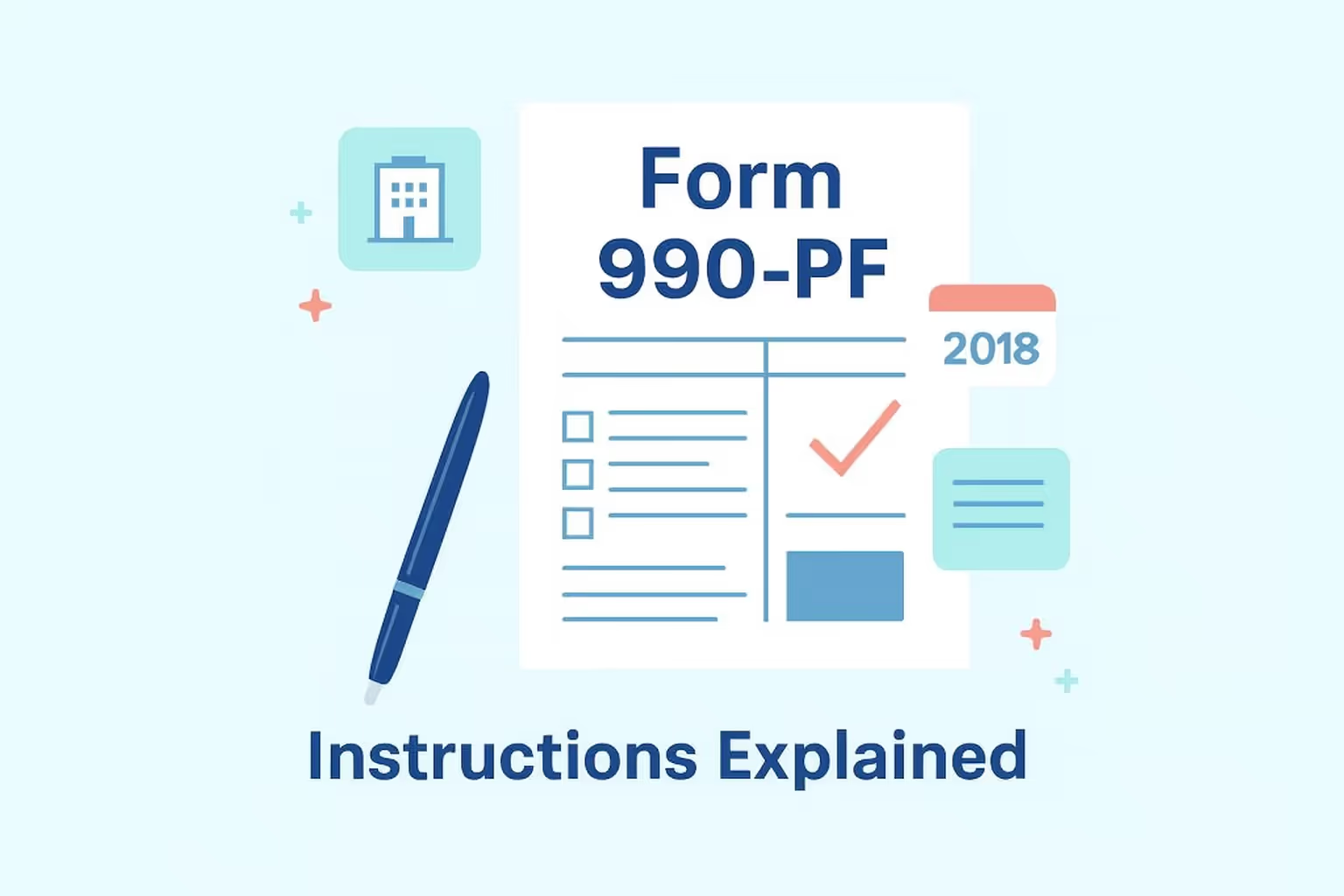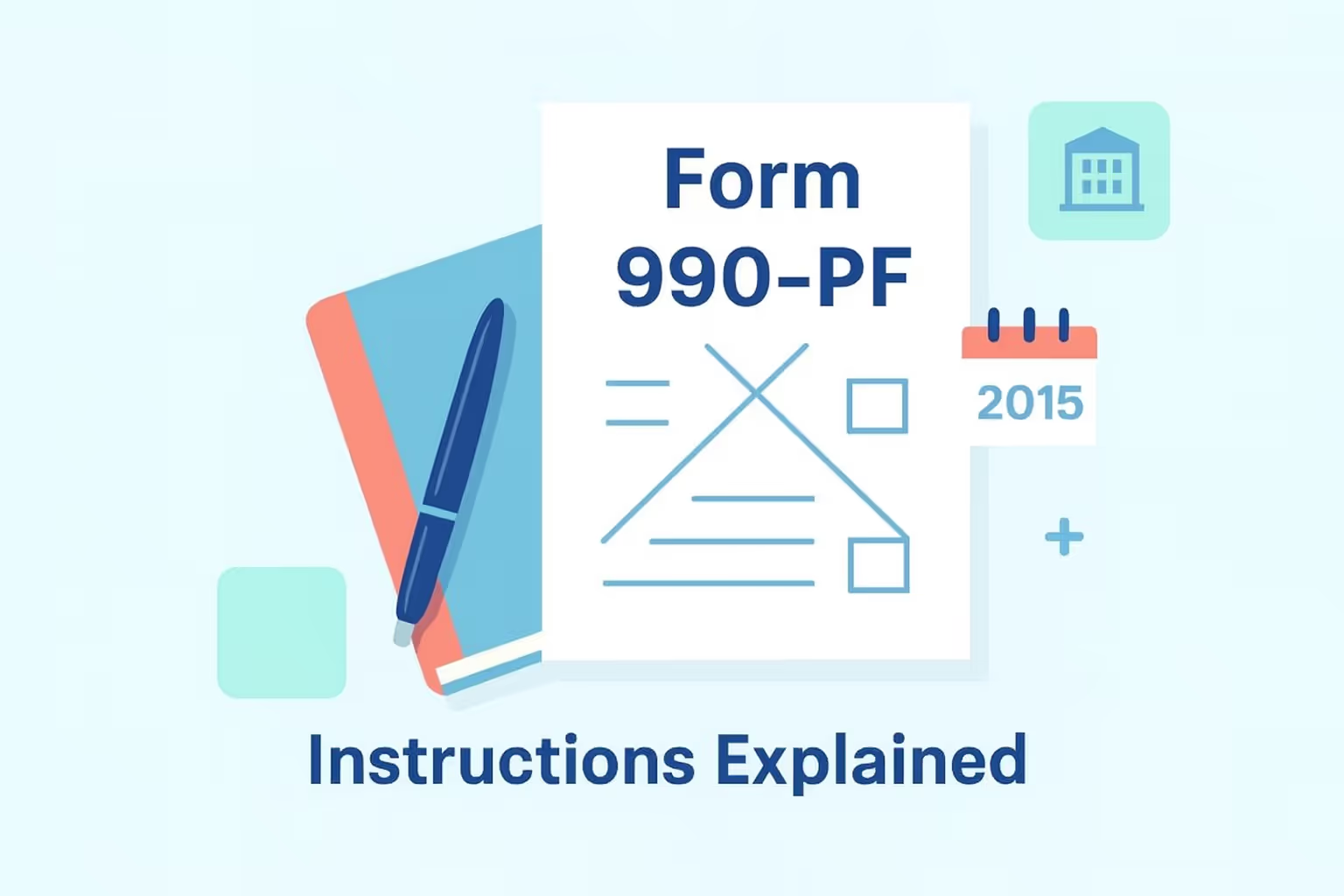Form 990-PF Filing 2019: Complete Guide for Foundations

Private foundations play an essential role in supporting charitable purposes, but filing the annual return of a private foundation can be intimidating. Many nonprofit organizations, including exempt private foundations and nonexempt charitable trusts treated as foundations, are required to complete this return annually. For the 2019 tax year, Form 990-PF remains the required document for reporting net investment income, income tax obligations, and charitable distributions. Understanding how to prepare and file this form is key to meeting Internal Revenue Service filing requirements.
Foundations often struggle with compliance due to the extensive reporting requirements that they face. These include reporting gross receipts and capital gains, as well as tracking adjusted net income and financial accounts. Organizations must also disclose program-related investments, direct charitable activities, and administrative expenses. The rules are strict because they ensure foundations show transparent and accountable use of their funds. Even when income tax remains unpaid, the IRS expects timely reporting, which helps maintain public confidence in private foundation status.
This guide is designed to simplify the process by clearly and concisely explaining the requirements. It will cover how to confirm tax-exempt status, claim private foundation status when applicable, calculate excise tax based on net income, and file according to an organization’s accounting period. By following these guidelines, nonprofit organizations can fulfill their obligations, minimize the risk of errors, and continue providing financial support to the communities they serve.
Form 990-PF 2019 Instructions
Form 990-PF, also titled the Return of Private Foundation, is required for domestic private foundations, exempt private foundations, and any nonexempt charitable trust treated as a foundation under section 4947(a)(1). This document establishes compliance with the Internal Revenue Service by reporting net investment income, documenting charitable distributions, and calculating excise tax-based obligations. It also verifies an organization’s accounting period and its continued status as a private foundation under the Internal Revenue Code.
The filing process ensures financial transparency and accountability. A complete income tax return requires disclosure of gross receipts, gross investment income, adjusted net income, and capital gain net income. Each element highlights how a foundation manages its federal income tax obligations and whether it qualifies for ongoing tax-exempt status. Correct reporting fosters confidence in nonprofit organizations and helps prevent errors that could affect exempt status.
Key Reporting Areas in Form 990-PF
- Return of Private Foundation function: This serves as the annual income tax return required of private foundations and specific trusts under federal law.
- Financial details: This section requires reporting gross income, interest income, and program-related investments.
- Charitable distributions include grants, direct philanthropic activities, and qualifying distributions.
- Excise tax-based obligations: Net investment income, including dividends, rents, and capital gains, must be reported at the 1.39 percent tax rate.
- Unpaid tax filings: Submission is mandatory even when income tax remains unpaid during the fiscal tax year.
Administrative expenses and related expenses tied to charitable purposes also require documentation. Each entry in Form 990-PF determines whether a foundation’s federal income tax filing is complete and accurate. Domestic private foundations that misreport may face scrutiny regarding their exempt status or compliance as tax-exempt organizations.
The Internal Revenue Service provides official guidance through the 2019 Instructions for Form 990-PF (PDF). Following these directions enables foundations to accurately record their financial accounts, confirm their status as a private foundation, and maintain their charitable purposes. This allows nonprofit organizations to demonstrate responsibility, protect their compliance record, and maintain community trust.
Exempt Status and Employer Identification Number
Private foundations must establish and maintain both their exempt status and their Employer Identification Number (EIN) to remain in good standing with the Internal Revenue Service. These elements confirm legal identity, demonstrate eligibility under the Internal Revenue Code, and form the foundation of every income tax return. Together, they ensure that organizations report their net investment income, financial accounts, and charitable distributions with accuracy.
Understanding Exempt Status
Exempt private foundations, nonexempt charitable trusts treated as foundations, and organizations claiming private foundation status all file Form 990-PF annually. This rule applies even when gross receipts or charitable distributions are minimal. Filing confirms adherence to federal income tax law and protects the organization’s ability to operate as a tax-exempt entity.
Claiming or Maintaining Status
Organizations applying for recognition must still file Form 990-PF while their exemption request is pending. Nonexempt charitable trusts treated as private foundations under section 4947(a)(1) must also follow these rules. Inaccurate or late filings may raise concerns about whether a foundation continues to qualify as a private foundation. Accurate reporting of adjusted net income and charitable purposes reinforces credibility with regulators and the public.
Employer Identification Number Essentials
The Employer Identification Number links a foundation’s income tax return to the correct entity. This nine-digit identifier ties the organization’s accounting period, excise tax-based obligations, and net income reporting to its legal records. Errors with EIN reporting can delay processing or create inconsistencies across federal filings. Every return must use the EIN exactly as issued by the Internal Revenue Service.
Why Accuracy Matters
Accurate recognition of exempt status, combined with proper EIN reporting, safeguards an organization’s compliance record. These requirements confirm financial support for charitable distributions, ensure appropriate payment of income taxes, and maintain confidence in nonprofit organizations. Private foundations provide the necessary structure to continue fulfilling their philanthropic purposes while meeting federal requirements.
Tax-Based Obligations and Excise Tax
Private foundations are required to fulfill several tax-related obligations annually to remain compliant with the Internal Revenue Code. These obligations ensure that net investment income, excise tax payments, and other income sources are reported correctly to the Internal Revenue Service. Accurate reporting supports transparency and helps preserve the private foundation's status.
- Gross receipts: Foundations must disclose the full amount of gross receipts received during the fiscal tax year before deducting expenses. This requirement establishes a clear record of the organization’s financial activity and aligns with federal income tax return obligations.
- Gross investment income: This category includes dividends, rents, royalties, and interest income. Because investment earnings are central to most nonprofit organizations, detailed reporting ensures that income is tracked correctly and supports the organization's charitable purposes.
- Adjusted net income: Certain foundations calculate adjusted net income to reflect allowable deductions and adjustments under the Internal Revenue Code. This calculation helps determine compliance obligations and ensures consistency in reporting across tax-exempt entities.
- Capital gain net income: Profits realized from the sale of assets must be reported separately from unrealized gains. This distinction clarifies a foundation’s financial accounts and ensures excise tax calculations include only realized capital gains.
- Excise tax-based payments: For the 2019 tax year, private foundations applied a flat 1.39 percent rate to their net investment income. The IRS Tax on Net Investment Income guidance explains how organizations must calculate and report this requirement each year.
- Unpaid tax obligations: Filing remains mandatory even when tax remains unpaid at year’s end. Completing Form 990-PF in these cases confirms responsibility and maintains compliance with Internal Revenue Service rules.
Comprehensive disclosure of these items strengthens the credibility of nonprofit organizations. By meeting all reporting obligations, private foundations demonstrate financial responsibility, protect their exempt status, and confirm their continued role as stewards of charitable resources.
Filing Deadlines and Fiscal Tax Year
Every private foundation must file its annual return within strict deadlines that align with its fiscal tax year. Meeting these filing obligations protects the foundation’s exempt status, ensures accurate reporting of net investment income, and supports compliance with the Internal Revenue Code. Missing a deadline can result in additional interest charges on unpaid taxes, raising concerns about the organization’s financial management.
Filing requirements differ depending on whether a foundation uses a calendar year or a fiscal year basis. Calendar-year filers follow a May 15 deadline, while fiscal-year filers must file by the 15th day of the fifth month following the close of their accounting period. Understanding these differences enables nonprofit organizations to manage their financial accounts effectively, prepare excise tax-based payments, and avoid late submissions.
Filing Deadlines by Foundation Type
Calendar-Year Foundation
- Accounting Period: January 1 – December 31
- Regular Due Date: May 15, 2020
- Extended Deadline (with Form 8868): November 15, 2020
- Notes: Applies to most domestic private foundations and exempt private foundations.
Fiscal-Year Foundation
- Accounting Period: Any 12-month period other than the calendar year
- Regular Due Date: 15th day of the 5th month after the fiscal year ends
- Extended Deadline (with Form 8868): 6-month extension available
- Notes: EIN reporting must align with the organization’s accounting period.
Nonexempt Charitable Trust Treated as a Foundation
- Accounting Period: Same as the trust’s fiscal year
- Regular Due Date: Same rules as private foundations
- Extended Deadline (with Form 8868): 6-month extension available
- Notes: Must follow the same reporting standards as private foundations under section 4947(a)(1).
Foundations may request an extension of time to file by submitting Form 8868. An approved extension provides six additional months, but it does not extend the time to pay income taxes or excise tax owed. Organizations must still make payments by the original deadline to avoid unpaid tax balances and interest charges.
Meeting filing deadlines helps foundations show sound financial management, safeguard their private foundation status, and maintain credibility with both the Internal Revenue Service and the public. Staying organized throughout the fiscal tax year ensures that all reporting obligations, from gross receipts to adjusted net income, are completed accurately and on time.
Minimum Investment Return and Undistributed Income
Private foundations must calculate a minimum investment return each year to determine their required charitable distributions. This calculation ensures that foundations contribute a set percentage of their assets to charitable purposes, rather than accumulating income for future use. If distributions fall short of the required amount, the difference becomes undistributed income and may create compliance issues with the Internal Revenue Service.
Undistributed income can result in excise tax liabilities under the Internal Revenue Code. The rules exist to ensure that tax-exempt organizations continue fulfilling their charitable missions while enjoying favorable tax treatment. By following each step carefully, private foundations can ensure that their philanthropic distributions meet the minimum standards and avoid the risks associated with holding excess business holdings or engaging in prohibited tax shelter transactions.
Step 1: Identify Applicable Assets
Foundations begin by determining the fair market value of their investment assets, such as securities, interest income, and capital gains. This calculation serves as the basis for determining the minimum required return on investment.
Step 2: Calculate the Minimum Investment Return
The Internal Revenue Code requires foundations to use a fixed percentage—generally 5 percent of average monthly asset value—to calculate the minimum amount needed for qualifying distributions.
Step 3: Subtract Related Expenses
Foundations may deduct expenses directly tied to managing investments, such as advisory fees or mortgage interest, from the calculation. Accurate reporting ensures the adjusted net income aligns with federal requirements.
Step 4: Compare With Actual Charitable Distributions
Foundations must measure their qualifying distributions, including direct charitable activities, program-related investments, and grants, against the required minimum. When the amount distributed meets or exceeds the threshold, the organization remains compliant.
Step 5: Address Undistributed Income
When charitable distributions fall below the minimum, the shortfall becomes undistributed income. This amount must be reported on Form 990-PF, and the foundation may face excise tax-based obligations until the distribution requirement is satisfied.
Step 6: Plan for Future Compliance
Foundations should track fund balances, expected investment income, and gross receipts to plan required distributions. This approach helps reduce the risk of accumulating undistributed income in later years.
By completing these steps, foundations protect their private foundation status while ensuring their resources actively support charitable purposes. Proper reporting and planning confirm compliance, safeguard the organization’s tax-exempt status, and reinforce accountability to the communities they serve.
Private Foundation or Section 4947(a)(1) Trusts
Private foundations and Section 4947(a)(1) nonexempt charitable trusts both file Form 990-PF, but their classifications under the Internal Revenue Code differ. Each must report net investment income, disclose philanthropic distributions, and document excise tax obligations. By understanding how these entities are defined and treated, organizations can ensure they remain compliant with federal income tax law.
Private Foundations
A single donor, a family, or a corporation typically funds private foundations. They maintain exempt status but face restrictions on holding excess business holdings, engaging in self-dealing, and entering into specific contracts that benefit them personally.
Each foundation must calculate excise tax based on net investment income and meet minimum investment return requirements through qualifying distributions. Transparent reporting of fund balances, gross receipts, and direct charitable activities on Form 990-PF ensures oversight to both the Internal Revenue Service and the public.
Section 4947(a)(1) Trusts
A Section 4947(a)(1) trust is a nonexempt charitable trust treated as a private foundation for tax purposes. While not exempt in the same way as private foundations, these trusts must follow identical filing obligations. They are required to report adjusted net income, capital gain net income, and related expenses, and they must demonstrate that financial support continues to be directed toward charitable purposes. Filing Form 990-PF creates parity between these trusts and domestic private foundations.
Shared Responsibilities
Both private foundations and Section 4947(a)(1) trusts share core compliance obligations. They must file annual income tax returns, document charitable distributions, and track program-related investments. They are also required to disclose undistributed income, report on excise tax-based obligations, and pay income taxes where applicable. Even if tax remains unpaid at year’s end, filing cannot be skipped.
Compliance Importance
The Internal Revenue Code requires detailed financial accounts from both entity types to ensure transparency and accountability. Accurate disclosure of gross investment income, capital gains, and charitable distributions demonstrates accountability. Compliance not only preserves federal recognition but also strengthens public trust by confirming that resources are being directed toward charitable purposes.
Understanding both private foundations and Section 4947(a)(1) trusts reinforces why the Internal Revenue Service requires identical filing treatment. Through accurate reporting, these organizations maintain their recognition under federal law and continue to fulfill their charitable missions.
Reporting Expenses and Specialized Disclosures
Private foundations and Section 4947(a)(1) trusts must provide detailed expense and disclosure information on Form 990-PF. These requirements confirm that administrative expenses, program-related investments, and charitable distributions are accurately recorded and reported. Proper classification ensures that financial accounts reflect both operational needs and the foundation’s charitable purposes.
The Internal Revenue Service expects expenses to be clearly distinguished between those that directly advance charitable purposes and those that support administration. Clear separation of these categories helps prevent misstatement of adjusted net income or net investment income. Accurate disclosure also strengthens public trust by clarifying how a foundation allocates its resources.
Key Reporting Areas
- Administrative expenses: Salaries, benefits, professional service fees, office costs, and insurance must be reported as part of the foundation’s records. These entries reflect the costs associated with compliance and organizational governance.
- Program-related investments: Funds invested in ventures that further charitable purposes must be identified separately from standard investments. This requirement confirms that financial support aligns with mission-driven activities.
- Direct charitable activities: Costs tied directly to carrying out programs, such as scholarship payments or community services, must be reported as part of qualifying distributions.
- Excess business holdings: Foundations must report ownership interests in businesses that could affect compliance with Internal Revenue Code restrictions.
- Specific personal benefit contracts: Arrangements that provide benefits to insiders must be disclosed, as these may impact the foundation’s exempt status if not correctly managed.
- Prohibited tax shelter transactions: Any involvement in tax shelter arrangements must be reported, and adherence to compliance standards must be demonstrated.
Specialized disclosures also include fund balances, capital gains, net income, and mortgage interest when applicable. These categories highlight how financial activity interacts with excise tax-based obligations and federal income tax reporting. By addressing these disclosures, organizations can maintain their credibility as tax-exempt entities.
Thorough expense reporting and disclosure of specialized transactions allow foundations to meet their obligations under the Internal Revenue Code. They demonstrate that charitable resources are used responsibly, that income tax return filings are accurate, and that compliance with IRS rules remains a priority. By maintaining precision in reporting, private foundations strengthen their accountability and preserve their role in supporting charitable purposes.
Filing Methods and Electronic Options
Private foundations and Section 4947(a)(1) trusts could choose between electronic filing and paper submission for Form 990-PF in the 2019 tax year. The method selected affected processing time, accuracy, and compliance preparation for future years. Both approaches required complete documentation of net investment income, charitable distributions, and excise tax-based obligations.
1. Electronic Filing
Electronic filing offered efficiency and reliability. Approved IRS software reduced errors through built-in validation and provided immediate confirmation of receipt. Organizations also used an electronic signature authorization form to finalize the process, ensuring that gross receipts, adjusted net income, and fund balances were correctly reported.
2. Paper Filing
Paper filing remained an option for foundations with accounting periods beginning before July 2, 2019. These organizations mailed their completed returns, with the Employer Identification Number and supporting schedules, directly to the Internal Revenue Service. Certified mail or delivery confirmation was recommended to establish proof of filing.
3. Documentation Requirements
Both filing methods required thorough documentation. Foundations were required to include details on financial accounts, program-related investments, and direct charitable activities. Retaining copies of submitted forms and acknowledgments for at least three years supported future income tax return accuracy.
4. Compliance Records
Maintaining compliance records protected the organization’s exempt status. Whether filed electronically or on paper, records of excise tax paid, undistributed income, and qualifying distributions demonstrated accountability under the Internal Revenue Code.
5. Future Filing Transition
Electronic filing became mandatory beginning in 2020. Foundations that adopted electronic methods early gained experience with the system and reduced filing burdens. The Internal Revenue Service provided a secure platform through E-file for Charities and Nonprofits, which supported faster and more accurate submission.
Both filing methods in 2019 required accuracy and diligence. Choosing between electronic and paper options enabled organizations to strike a balance between efficiency and preference, while preparing for the future transition to mandatory electronic filing. The proper completion of Form 990-PF reinforced transparency, protected exempt status, and showed that charitable resources were managed responsibly.
Frequently Asked Questions
Do all private foundations need to file Form 990-PF for the 2019 tax year?
Yes, every domestic private foundation, including those with tax-exempt status and those recognized as a private foundation or section 4947(a)(1) trust, must file Form 990-PF for 2019. This requirement applies regardless of gross receipts, net income, or whether charitable distributions were made. Filing ensures compliance with the Internal Revenue Code and confirms that organizations remain accountable for their foundation’s charitable purposes and financial reporting obligations.
What if my foundation had no activity or income during the tax year?
Foundations must still file even during a year with no financial activity. The return should reflect zero values for adjusted net income, interest income, and charitable distributions. Administrative expenses, such as bank charges, must still be reported. Completing the return safeguards the organization’s tax-exempt entity classification, prevents unpaid tax issues, and preserves compliance, even if the foundation had no gross income, grants, or program-related investments during the reporting period.
How is the excise tax based on net investment income?
For 2019, domestic private foundations calculated their excise tax at a flat rate of 1.39% of their net investment income. This includes dividends, capital gains, rents, and other gross investment income. If tax remains unpaid or the quarterly estimated tax is not submitted, the foundation risks accumulating interest. Reporting this calculation on Form 990-PF confirms compliance and shows that financial accounts and qualifying distributions meet the foundation’s requirements under the Internal Revenue Service.
When must estimated tax payments be made?
Estimated tax applies if a foundation expects to owe $500 or more in excise tax for 2019. Payments are due on the 15th day of the 5th, 6th, 9th, and 12th months of the fiscal tax year. Submitting estimated tax ensures that tax obligations related to gross investment income and adjusted net income are paid on time and in full. This practice supports overall tax compliance for exempt private foundations and related nonprofit organizations.
What information about officers, directors, and managers is required?
Form 990-PF requires disclosure of all officers, directors, trustees, and foundation managers. The report includes names, positions, compensation, and weekly hours devoted to foundation operations. These disclosures confirm accountability in managing charitable distributions, excise tax-based obligations, and program-related investments. Listing governance details demonstrates compliance with federal income tax reporting standards and ensures transparency when nonprofit organizations maintain their tax-exempt status under the Internal Revenue Code.
How should undistributed income and minimum investment return be reported?
Undistributed income occurs if qualifying distributions fall below the minimum investment return requirement. Foundations must calculate the shortfall using fund balances, gross income, and net investment income. Any unpaid tax must be reported until compliance is achieved through future charitable distributions. Addressing these requirements on Form 990-PF reinforces tax compliance, prevents the accumulation of excess business holdings, and safeguards the organization’s tax-exempt entity status while supporting its charitable purposes.
What are program-related investments, and why are they important?
Program-related investments are financial commitments that directly support the foundation’s charitable purposes. Unlike unrelated business income, these investments demonstrate that resources benefit the community rather than private gain. Form 990-PF requires organizations to report program-related investments alongside gross investment income, adjusted net income, and capital gain net income. Proper disclosure supports the foundation’s exempt status and ensures tax compliance under the Internal Revenue Code for tax-exempt organizations.



























